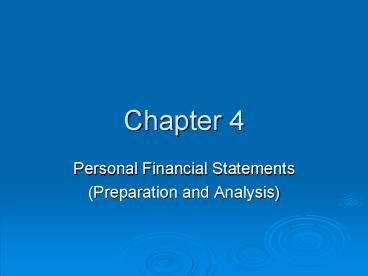Personal Financial Statements - PowerPoint PPT Presentation
1 / 26
Title:
Personal Financial Statements
Description:
Cash and Cash Equivalents. Checking, savings, MM accts. CD's, tax refunds, ... Cash Flows from Investing Activities. Reclassify savings. Purchase/sale of assets ... – PowerPoint PPT presentation
Number of Views:277
Avg rating:3.0/5.0
Title: Personal Financial Statements
1
Chapter 4
- Personal Financial Statements
- (Preparation and Analysis)
2
Financial Statements Provide Information About
- Financial resources available to client
- How resources were acquired
- What the client has accomplished financially
utilizing these resources
3
Personal Financial Statements
- Balance Sheet
- Income Statement
- Statement of Cash Flows
- Statement of Changes in Net Worth
4
Financial Statements are Used
- By clients to benchmark goal achievement
- By planners to help clients set financial
direction - By creditors lenders to make decisions to
extend, continue, or call indebtedness
5
Balance Sheet Terms
- Asset
- Liability
- Net Worth
6
Asset Categories Classifications
- Cash and Cash Equivalents
- Liquidity easily converted to cash
- Current Assets converted within a year
- Investment Assets
- Held for growth and/or income
- Personal Use Assets
- Long-lived assets
- Used to maintain quality of life
7
Asset Categories Classifications
- Cash and Cash Equivalents
- Checking, savings, MM accts
- CDs, tax refunds, CVLI (current use)
- Investment Assets
- Stocks, bonds, mutual funds
- CVLI (not current use)
- Real estate, collectibles, business interests
- Retirement accounts annuities
8
Asset Categories Classifications
- Personal Use Assets
- Primary residence
- Vacation home
- Automobiles
- Recreational vehicles
- HH items
- Jewelry
9
Liability Categories Classifications
- Current Liabilities
- Current portion of mortgage
- Utilities
- Credit cards
- Insurance premiums
- Taxes due
- Medical bills due repair bills due etc.
10
Liability Categories Classifications
- Long-Term Liabilities
- Primary residence mortgage
- Vacation home mortgage
- Other mortgages (2nd)
- Auto loans
- Student loans
- Other loans
11
Information Sources
- Bank Statements
- Investment account statements
- Life insurance statements
- RE purchase agreement
- Mortgage notes
- Car and other notes
- Credit card statements
- Employer benefit statements
- Appraisals
12
The Income and Expense Statement
- Is a summary of the clients income and expenses
during an interval of time, usually one year - May focus on realized transactions, and if so,
helps compare to budgeted financial goals - Should prepare actual and budget
13
Income Statement Terms
- Income
- Employment
- Salary W2/tax return
- Investment
- Interest/dividends -- 1099
- Other
14
I/S Terms - expenditures
- Savings
- Expenses
- Fixed recur every month
- House payment
- Car payment
- Insurance premium
- Child support/daycare/etc.
- Variable
- Food
- Utilities
- Discretionary
- Vacation/entertainment/gifts
15
The Statement of Cash Flows
- For a given period, the statement of cash flows
- Shows the inflows and outflows and the net change
in cash between two balance sheets - Identifies the changes in some of the accounts
from one balance sheet to the next
16
Statement of Cash Flows Classifications
- Cash Flows from Operations
- Cash Flows from Investing Activities
- Reclassify savings
- Purchase/sale of assets
- Cash Flows from Financing Activities
- Proceeds from additional borrowings
- Reclassify principal payments
17
Ratio Analysis
- The key to ratio analysis is
- Does the ratio get to the answer for the question
asked? - Is there some standard or benchmark to determine
whether the result is appropriate for this
particular client?
18
Ratio AnalysisThe Objective
- The objective of ratio analysis is twofold
- To gain additional insight into the financial
situation and behavior of the client - To generate questions for the client to answer to
further gain such insight
19
Types of Ratio Analysis
- Liquidity ratios emergency fund ratio and
current ratio - Emergency Fund Ratio Liquid Assets/Monthly
nondiscretionary expenses - Target ? 3-6 months
- Current Ratio Current Assets/Current
Liabilities - Target 1.1 2.1
20
Types of Ratio Analysis
- Debt ratios total debt to net worth, long-term
debt to net worth, debt to total assets,
long-term debt to total assets - No targets
- Quality debt (mtg) low quality (credit card)
- Matching duration with benefit created
21
Types of Ratio Analysis
- Monthly housing cost/Gross monthly income ? (mortgage lenders)
- Housing cost Princ Int RET Ins
- Housing Cost Other Debt Pymt/Gross Monthly
Income ?
22
Performance Ratios - Savings
- Annual Savings / Annual Gross Income
- Annual Savings / Annual Gross Income
- Savings Personal Employer related
- BK ? 10 at 30 15 at 40
- Discretionary CF Savings/Annual Gross Income
23
Performance Ratios - Investments
- Rate of Return on Investment
- (EI BI Savings Gifts)/ Avg Investment
- Average Investment (EI BI)/2
- Investment Assets / Gross Income
- 10 at normal retirement
- 3-4 x, 10 years prior to retirement
- 1, 20 years prior to retirement
24
Vertical Growth Analysis
- Vertical analysis
- Balance sheet each item presented as a percent
of total assets - Income statement each item presented as a
percent of total income - Growth analysis
- Calculates the growth rate of certain financial
variables over time using TVM tools
25
Limitations of Financial Statement Analysis
- Inflation
- Use of estimates
- Few benchmarks for individuals
26
Sensitivity Analysis Risk Analysis
- Sensitivity analysis allows the manipulation of
numerators and denominators by small increments
to determine the impact on the ratio - Risk analysis examines the uncertainty of cash
flows to the individual - Income risk
- Expenditure risk

